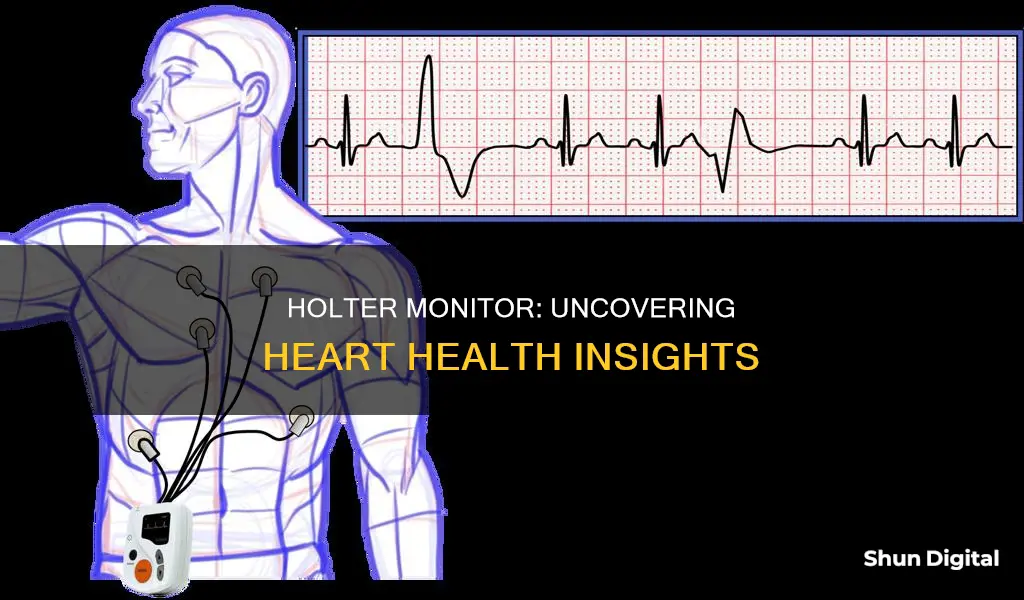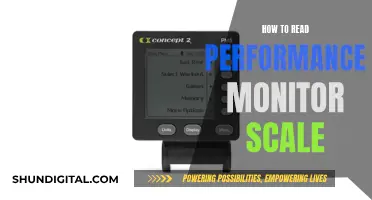
A Holter monitor is a type of portable electrocardiogram (ECG) that records the heart's electrical activity over 24 to 48 hours or more, while the patient goes about their daily life. It is a small, wearable device that helps healthcare providers evaluate a patient's heart health and diagnose problems that may not be detected during a standard ECG test. The monitor is usually worn around the neck or waist, and the patient is instructed to keep a diary of their activities and symptoms during the test period.
| Characteristics | Values |
|---|---|
| What it is | A Holter monitor is a type of portable electrocardiogram (ECG) that records the electrical activity of the heart over 24 hours or longer. |
| Size | The size of a small camera |
| How it works | It is battery-operated and has wires with small discs (electrodes) that attach to your skin to record the ECG continuously. |
| Who needs it | People with inconclusive electrocardiograms (ECG or EKG) or symptoms such as dizziness, fainting, low blood pressure, ongoing tiredness, or palpitations. |
| What it can find | The Holter monitor can find the cause of arrhythmia (heart rhythm abnormalities) and unexplained dizziness. |
| When it's not appropriate | When urgent treatment for heart symptoms is required, or for routine screening if the patient does not have symptoms. |
| Risks | There are no significant risks associated with the Holter monitor, but some people may experience mild skin irritation from the electrodes. |
What You'll Learn

It can help diagnose heart rhythm abnormalities
A Holter monitor is a type of heart monitor that records your heart's activity over 24 to 48 hours or longer, depending on the type of monitoring used. It is a battery-operated portable electrocardiogram (ECG or EKG) device that measures and records the heart's electrical activity as you go about your daily life.
During the test, you will be instructed to keep a diary of your activities and symptoms, especially any symptoms related to heart rhythm problems such as dizziness, palpitations, chest pain, or shortness of breath. This diary will be compared to the changes in your ECG recorded by the Holter monitor.
After the test period, the monitor will be returned to the technician, who will process the record of your heart activity and prepare a report for your healthcare provider. This report will include the notes from your diary. The results of the test will typically be available within one to two weeks.
The Holter monitor is a valuable tool for diagnosing heart rhythm abnormalities as it provides a comprehensive picture of your heart's activity over an extended period, helping healthcare providers identify any arrhythmias that may be causing your symptoms.
Connecting a Desktop to a Projector: Monitor Setup
You may want to see also

It can determine if your medicines are working
A Holter monitor can be used to determine if your medicines are working. The device is used to monitor the heart's activity over 24 to 48 hours or longer, depending on the type of monitoring used. During this time, the monitor will record the heart's electrical activity, which can be used to assess the effectiveness of medication.
The Holter monitor is a battery-operated portable electrocardiogram (ECG or EKG) device. It is about the size of a small camera and is worn around the shoulder, neck, or waist. The device has wires with small discs (electrodes) that attach to the skin to record the ECG continuously.
When a person has a Holter monitor test, they wear the device while carrying out their normal daily activities. The monitor records the heart's electrical activity during this time, which can be analysed for any cardiac arrhythmias or signs of cardiac ischemia. The monitor can also be used to evaluate symptoms that may be heart-rhythm related, such as chest pain, tiredness, shortness of breath, dizziness, or fainting.
By wearing the Holter monitor and recording the heart's electrical activity over an extended period, healthcare providers can assess the effectiveness of medication. The monitor can help to determine if the medication is successfully treating any abnormal heart rhythms or other cardiac issues.
Additionally, the Holter monitor can be used to assess the heart's response to new medications. If a person is starting a new heart medication, the monitor can be used to evaluate the heart's response and ensure that the medication is working as intended. This can be particularly important for individuals with heart conditions who need to carefully manage their treatment.
In summary, a Holter monitor can indeed be used to determine if your medicines are working. By recording the heart's electrical activity over an extended period, the device provides valuable data that can be used to assess the effectiveness of medication and guide treatment decisions.
Monitor Facing: How to Ensure Correct Viewing Angle
You may want to see also

It can help identify why you have symptoms like dizziness or a racing heart
A Holter monitor is a type of portable electrocardiogram (ECG) that can be used to help identify why you are experiencing symptoms like dizziness or a racing heart. It does this by recording your heart's electrical activity over 24 to 48 hours while you go about your daily life. This continuous recording of your heart's rhythms and rate activity gives your healthcare provider a full picture of what your heart is doing when you are away from their office.
As a Holter monitor records every single heartbeat over a prolonged period, it is much more likely to detect any transient arrhythmias that may be causing your symptoms. For example, you may have an arrhythmia that is infrequent and unpredictable, only present for brief periods, and causing symptoms that disappear by the time you reach a medical facility. A Holter monitor can capture these fleeting arrhythmias, as well as any associated symptoms, which can then be compared to your ECG results.
In addition, a Holter monitor can be used to determine if your symptoms are related to how your heart responds to normal activity. It can also be used to evaluate your heart after a heart attack, or when starting a new heart medicine.
Before you wear a Holter monitor, a technician will attach the electrodes to your chest, and may need to shave your chest to ensure the electrodes stay attached. You will then be instructed on how to take care of the monitor, and how to keep a diary of your activities and symptoms during the test period.
Identifying 10-Bit Monitors: What to Look For
You may want to see also

It can assess if your heart is getting enough oxygen
A Holter monitor can be used to assess if your heart is getting enough oxygen. This is done by analysing the electrical activity of the heart over a 24- to 48-hour period while the patient goes about their normal daily activities. The monitor is battery-operated and portable, and is about the size of a small camera. It is worn around the shoulder, neck or waist.
The Holter monitor is a type of electrocardiogram (ECG or EKG) that records the heart's electrical activity continuously over a longer period than a standard ECG. It is particularly useful for detecting infrequent or fleeting cardiac arrhythmias, which may only occur outside of a clinical setting.
The monitor is attached to the patient's chest with wires and small, sticky patches called electrodes. The patient is instructed to keep a diary of their activities and symptoms during the test period, including any chest pain, shortness of breath, dizziness or palpitations, and the time of day they occur. This information will be compared to the changes in the ECG recorded by the Holter monitor.
After the test period, the monitor is returned to the technician, who will process the record of the patient's heart activity and prepare a report for their healthcare provider. The results of the test are typically available within one to two weeks.
Removing FPS Counter: A Guide for ASUS Monitor Users
You may want to see also

It can be used to see how well a pacemaker is working
A Holter monitor is a type of portable electrocardiogram (ECG) that records the electrical activity of the heart over 24 hours or longer. It is a small, wearable device that records the heart's rhythm and rate activity. The Holter monitor is named after its inventor, Dr Norman J. Holter, who created it in the 1950s.
The device is used to evaluate symptoms that may be related to heart rhythm, such as chest pain, tiredness, shortness of breath, dizziness, or fainting. It can also be used to identify irregular heartbeats or palpitations and to assess an individual's risk for future heart-related events.
One of the reasons a healthcare provider may request a Holter monitor is to see how well a pacemaker is working. The monitor can be used to determine if the pacemaker is effectively regulating the heart's rhythm and rate activity. By comparing the data from the Holter monitor with the patient's reported activities and symptoms, healthcare providers can assess the overall effectiveness of the pacemaker.
The Holter monitor is typically worn for 24 to 48 hours, during which the patient can continue their regular daily activities. The device is small and can be carried in a pocket or bag, or worn on a strap around the neck or waist. After the monitoring period, the patient returns the device to a technician, who processes the data and prepares a report for the healthcare provider.
The use of a Holter monitor to evaluate pacemaker function can provide valuable insights into the effectiveness of the device and help healthcare providers make informed decisions about the patient's treatment plan. It offers a comprehensive view of the heart's activity over an extended period, allowing for a more accurate assessment of the pacemaker's performance.
LCD Monitor Functionality: Understanding the Inner Workings
You may want to see also
Frequently asked questions
A Holter monitor is a portable electrocardiogram (ECG) device that records the heart's electrical activity over 24 to 48 hours or more. It is battery-operated and about the size of a small camera.
A Holter monitor can be used to evaluate symptoms that may be related to heart rhythm, such as chest pain, tiredness, dizziness, or fainting. It can also be used to identify irregular heartbeats or palpitations, assess your risk for future heart-related events, and see how well your heart medications or pacemaker are working.
There are minimal risks associated with a Holter monitor. The electrodes are attached to the skin with tape or adhesives, which may cause mild skin irritation or discomfort when removed.
You don't need to do anything special to prepare for the test. However, you may need to shave your chest to ensure the electrodes attach firmly to your skin. You should also avoid showering or bathing before the test as you will not be able to do so while wearing the monitor.







